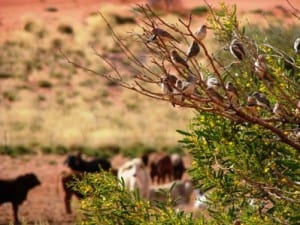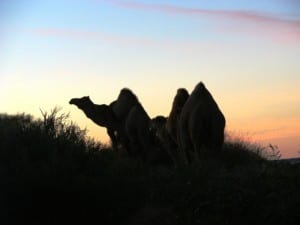Trapped in the desert – part two
By Jack Ashby, on 17 March 2011
A delayed account of zoological fieldwork in Australia – Part 8
From April 2010 I spent about five months undertaking several zoological field projects across Australia. I worked with government agencies, universities and NGOs on conservation and ecology studies ranging from Tasmanian devil facial tumour disease, the effect of fire, rain and introduced predators on desert ecology and how to poison cats. This series of blog posts is a delayed account of my time in the field.
Week Nine
Last week I went through the tactics for trapping small animals in pitfall traps in the Simpson Desert where I spent a month with the University of Sydney’s Desert Ecology Research Group. This week I’ll talk about some of the other things that we did while we were there.
Scattered across the three cattle stations (one operational, the other two having been been recently purchased by conservation NGO Bush Heritage who removed the cattle) are tens of pitfall trapping grids. The range of sites has allowed Chris Dickman and his team to study a variety of interactions between the local animals and their environment. Long-range studies look at the effect of rain on the animal populations, but surprisingly we weren’t seeing the massive boom predicted after the huge rains earlier in the year. We could see that the spinifex grass had sent up millions of seed-heads (as expected after rain) but looking closer the heads were mainly empty of seeds, which are the main food for many of the native rodents here. It goes to show how things aren’t simple and many factors contribute to a region’s ecology – something that can only be untangled by a long-range study over decades, like this one.
We were also looking at the effect of introduced animals. Like everywhere in Australia, the Simpson is over-run with animals that don’t belong here, brought over in the last 200 years by European settlers. Walking over a dune crest for a twilight stroll one night, I came across a group of feral camels, which gave me a bit of a fright. Camels are huge. Australia is the only place in the world where dromedary camels live wild, with an estimated one milllion living here. They were brought over to be desert-adapted beasts of burden as the Australian centre was settled by Europeans. They were made obsolete by vehicles and just left to go feral. Now they do huge damage to desert plants and water sources, and Bush Heritrage works hard to control them.
We were looking at the effect of cats and foxes on the native animals here. This was done by setting sand pads and camera traps. Making sand pads in the desert is easy – just smooth over the existing sand and visit the next morning and count the footprints. It was rare that a grid didn’t show signs of cats and fox every morning. To test their effect you need to compare areas with and without them. A suitable cat poison has yet to be developed (see the posts about the cat poisoning trial in WA), so foxes are the target for removal. In some areas dry 1080 poison baits were buried just under the soil at the sand pads. In many cases these were gone by the next day, and we could see it was foxes taking them from the tracks (burying the poison decreases the likelihood of dingoes taking them).
We also monitored predator numbers by driving set transects at night (when they are active) and spot-lighting for them. Animals can be identified in torch-light from a distance by the colour of the reflection from their eyes. Although it varies depending on your torch, cats are generally red, foxes and dogs are green or blue and cows are yellow. We would drive 10km at 10km per hour and record every animal we saw. The method used here was a bit hairy. Someone would sit on the roof of the 4×4 with the spot as the car drove. Although the desert tracks were extremely bumpy, at 10km/hr it’s not too bad. The problem arises when you try and cross a dune crest, which requires the engine to by revved hard and then released to surge over the top without getting bogged in the loose sand. This is done at significantly faster than 10km/hr.
____
The team from Sydney had people with a range of different expertise, some studying the interaction between plants and their specialist pollinators, some looking at how native predators (mulgaras and goannas) impact on prey species, and botanists studying all aspects of plant ecology. Not all of it involved the glamour of trapping mammals and rodeo-riding utes. I spent a good deal of time sieving sand to determine the effect of rodents on the seed-bank by looking at plots where herbivores are experimentally excluded. Dickman thinks that excluding the herbivores might actually disadvantage the plants as the sand is less disturbed by burrowing.
While the things we found and the environment we were in were fascinating, a big part of it was working with the people who had decided to spend serious amounts of time sleeping on the sand with no walls, no roofs, no toilet and no running water, all in the name of discovery. Next week I’ll be talking about the team I was with.
UPDATE: PART NINE HERE
2 Responses to “Trapped in the desert – part two”
- 1
-
2
UCL Museums & Collections Blog » Blog Archive » Trapped in the desert – part one wrote on 2 May 2011:

[…] UPDATE: PART EIGHT HERE […]
 Close
Close




[…] Last week I went through some of the activities I was involved in when I joined a month-long field trip to southwest Queensland’s Simpson Desert with the University of Sydney. This week I want to talk about the people who I was with… […]